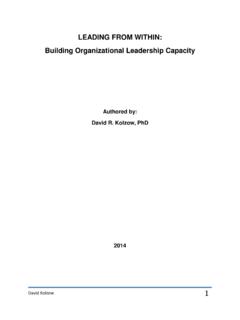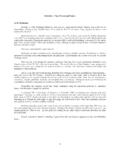Transcription of LEADING FROM WITHIN: Building Organizational …
1 LEADING from within : Building Organizational Leadership Capacity Authored by: David R. Kolzow, PhD. 2014. David Kolzow 1. 7 EADING from within : Building Organizational LEADERSHIP CAPACITY. Table of Contents Page #. Chapter 1: Introduction 5. Chapter 2: What Does It Mean to be a Leader? 9. Leadership Defined 9. Leadership in Transition 16. Chapter 3: Understanding the Foundations of Leadership 17. Leadership Models 17. Leadership Trait Theory 17. Leadership Behavior Theory 21. Contingency Theory and Situational Leadership Theory 24. Chapter 4: What's Your Leadership Style? 28. Authoritarian vs. Democratic Leadership 29. Power and Leadership 32. The Charismatic Leader 40. Transactional Leadership 42. Transformational Leadership 43. The Servant Leader 47. Situational Leadership 51. Conclusions About Leadership Styles 53.
2 Chapter 5: Demonstrating Effective Leadership 54. Leadership Character 54. Leadership Behavior 57. Being trustworthy 59. Integrity 66. Self-reflection 69. Self-confidence 73. Self-directed 75. Action- and results-oriented 77. Communication 78. Respecting and caring for others 82. Willingness to take risks and be innovative 85. Transparency 88. Righting wrongs 91. Staying focused 92. Responding quickly with agility 93. A positive attitude 94. Clarity 95. Chapter 6: Critical Leadership Competencies - What Makes a Successful Leader? 97. Introduction 97. David Kolzow 2. Possess clarity of direction 99. Has the ability to inspire others to high performance 99. Communicates well and listens intensively 100. Demonstrates a collaborative orientation 103. Works to develop people 105. Has the ability to think creatively 105.
3 Possesses intelligence and learning agility 107. Is capable of creating a culture of excellence 109. Practices consistent discipline 112. Delivers results 113. Clarifies expectations 114. Practices accountability 117. Exercises good judgment 118. Conclusions 124. Chapter 7: Learning Leadership Skills 125. Hard vs. Soft Skills 126. Interpersonal Skills 128. Communicate Effectively 129. Conflict Resolution 149. Negotiation 166. Problem-Solving and Critical Thinking 187. Decision-Making 203. Facilitation 218. Chapter 8: Leadership and Dealing with Change 225. The Reality of Change 226. Leader's Role in Change Management 227. Organizational Change 228. Change Leadership vs. Change Management 232. Facilitating Change 234. The Board and Change 238. Chapter 9: The Visionary Leader 241. Envisioning 241. Strategic Thinking 251.
4 Chapter 10: The Leader as Enabler 254. Empowerment 255. Coaching 259. Collaboration 264. Chapter 11: Building Leadership Capacity in the Organization 268. Levels of Leadership in the Organization 268. Who Are the Organization's Potential Leaders? 273. Building Volunteer Leaders in the Organization 277. How Do We Train New Leaders? 282. Chapter 12: The Economic Development Professional as Leader and Manager 295. Leader vs. Manager 298. Leadership and Accountability 302. David Kolzow 3. Facilitator and Consensus-Builder 305. The Practitioner as Educator 306. The Economic Developer as Community Leader 307. Chapter 12: Conclusions 310. Bibliography 311. David Kolzow 4. Chapter 1. INTRODUCTION. So why another book on leadership? Literally, hundreds of books on this topic grace the shelves of bookstores and libraries.
5 Communities across the nation offer annual training programs to improve civic leadership. Various state and local governments send their staff through leadership classes. Corporate training programs focus on leadership development. Leadership courses abound in adult education. And so on. The premise of this book is that despite all the attention to leadership development, nonprofit community and economic development organizations and government agencies could benefit from a more directed and structured program to develop effective leaders within and throughout their organization and thereby improve the quality of their operation. Studies have consistently demonstrated that organizations that prioritize leadership development are much more effective in meeting the expectations of their constituents, stakeholders, and customers.
6 It has been said that the better the leadership, the better the organization is able collectively to ride the challenges of difficult According to Bersin & Associates study entitled High-Impact Leadership Development (2008), an Organizational focus on leadership development results in: Becoming 84 percent more effective at raising the quality of the leadership pipeline; . A 73 percent increase in employee retention;. A 67 percent increase in the ability of the organization's members to work collaboratively; and, A 66 percent improvement in the organization's results. According to the 2008 IBM Global Human Capital Study, over 75 percent of the respondents identified Building leadership talent as their current and 1. Ken Sundheim, Defining , Improving and Teaching Leadership With Those Who Know It Best, , 10/28/2013.
7 David Kolzow 5. most significant capabilities challenge. Leaders today sometimes appear to be an endangered species. The second most important capacity Building challenge facing organizations in this study was fostering a culture that supports learning and development. Clearly, these two key challenges are closely related. Leadership, like the inner workings of a computer, is a complex set of relationships, systems, and processes that few fully master. Dave Ulrich, Global Consulting Alliance. Organizational life today is often a complex social environment of confrontation, miscommunication, manipulation, hostility, and conflict. Does that sound like an exaggeration to you? If so, take a good look at most organizations. So much of what takes place in virtually all organizations is grounded in the interrelationships of its members, and all human relationships have problems.
8 These interactions involve the work that is done, the goals that are set, and the decisions that are made. Without effective leadership, members of an organization often quickly degenerate into argument and conflict, because they each see things in different ways and lean toward different solutions. The core of the criticism of organizations in a lot of the literature is that all sorts of them (corporations, government agencies, and not-for-profit organizations) tend to be over-managed and under-led. Those organizations suffering from over-management tend to be slow to make necessary changes and therefore achieve less than what they could. In the organizations that are characterized by poor leadership, employees see very little that is positive. In a climate of distrust, employees learn that so- called leaders will act in ways that are not easily understood or that do not seem to be in the organization's best interests.
9 Poor leadership leads to an abandonment of hope, which, if allowed to go on for too long, results in an organization becoming completely dysfunctional. The organization must then deal with the practical impact of unpleasant change, but more importantly, must labor under the burden of employees who have given up, and have no faith in the system or in the ability of leaders to turn the David Kolzow 6. organization around. 2 This is a substantial criticism that points to the importance of leadership. Although most organizations would say that they are interested in becoming more effective and therefore more excellent, this is almost impossible without competent leadership. Barbara Blumenthal reported in her book Investing in Capacity Building that capacity- Building interventions often fail if strong Organizational leadership is not in The government official, the agency manager, the economic developer, the Chamber executive, and all staff in this new knowledge-based environment will need to assume the role of active networker and facilitator, both within his or her organization and with stakeholders and constituents.
10 Excellence means that top leadership does a number of things well, including creating a learning organization that trains and retains its talent. This is what it takes to achieve an organization that has a culture of character and integrity. A primary concern of most organizations today is the attraction and retention of talented people. However, they generally want to work for good leaders in an open environment where they can speak their minds freely, be treated with respect, and where leadership promotes clarity and honesty. Bad leaders are corrosive to an organization because they can drive out anyone who's good. Unfortunately, since many bad leaders are manipulative and deceptive, it is often a challenge to root them out and get rid of them. 4 The lack of positive and effective leadership is a key reason why many talented workers leave the organization.







